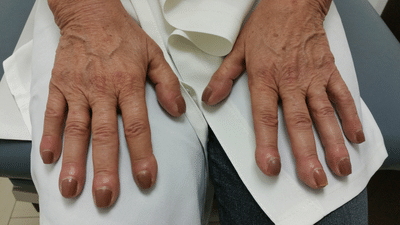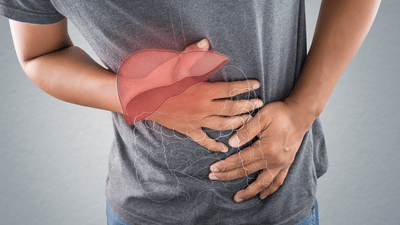When our nails start to appear rounder, thicker, and curved downward around the tips of our fingers, it may seem like just a little change. However, this physical indicator, known as nail clubbing, tends to be a subtle signal from your body that something more profound is amiss. Clubbing is not an illness in itself. Instead, it is a clinical indicator that points to underlying systemic diseases, most particularly including the lungs, heart, or liver.
What is nail clubbing

In clubbing of the nails, the usual 160-degree angle between the nail bed and the skin is greater than 180 degrees. The nail bed softens, the tips of the fingers become puffy, and the nails begin curving inwards, making the fingers bulbous. Physicians typically identify it through a mere visual inspection or by conducting the " Lovibond angle test." The alteration evolves over time and usually happens in both hands symmetrically.
The connection between clubbing and liver disease

Clubbing is most commonly linked to chronic liver illnesses like cirrhosis, primary biliary cholangitis, and hepatitis. The liver is an important organ that filters toxins, controls metabolism, and assists in maintaining the balance of the body's oxygen. If liver function is impaired, toxins and inflammatory chemicals begin to build up in the blood. This interferes with the transport of oxygen and leads to chronic hypoxia, when tissues are supplied with less oxygen than required.
Low oxygen levels also stimulate the release of factors like vascular endothelial growth factor (VEGF) and platelet-derived growth factor (PDGF). These induce development of new blood vessels and result in growth of tissue around the fingertips. With time, the under-nail soft tissue becomes hardened, and the nails become clubbed in the typical fashion. This is painless, gradual, and irreversible unless the liver condition is corrected.
The lovibond angle
The most widely known physical sign of clubbing is the profile sign, known as the Lovibond angle. The Lovibond angle is the angle found between the proximal nail fold and the nail at the location of the exit of the nail from the nail fold. Normally, this angle is less than 180 degrees; therefore, true digit clubbing can be differentiated from simple nail curving when the angle is greater than 180 degrees.
Why does it appear early

Perhaps most troubling about nail clubbing is that it usually occurs prior to other signs of liver disease, like jaundice, weakness, or edema, which can be seen by the naked eye. For this reason, physicians view it as an early warning sign. The identification of clubbing in a patient with nonspecific or subtle symptoms tends to lead to further investigation of liver function, possibly identifying diseases like cirrhosis or portal hypertension when they are in their incipient stages.
Is nail clubbing a sign of hepatopulmonary syndrome (HPS)
In some patients, yes. Hepatopulmonary syndrome is a rare complication of chronic liver disease . Hepato means liver and pulmonary means of the lungs, this condition is marked by low oxygen levels in the blood, making it harder to breathe.
In a research, PubMed Central, the study highlights the clinical significance of digital clubbing and dyspnea in the diagnosis of hepatopulmonary syndrome (HPS) among cirrhotic patients. Digital clubbing, with a positive predictive value (PPV) of 75%, emerged as the most reliable clinical indicator of HPS.
Other causes apart from liverWhile nail clubbing is often associated with chronic liver disease, particularly HPS or primary biliary cholangitis, it is not specific to hepatic pathology. Clubbing can also signal disorders affecting the lungs, heart and endocrine system, it can also signal towards: Cyanotic congenital heart disease and infective endocarditis, Gastrointestinal diseases-IBD, celiac diseases.
What should one doIf you observe changes like soft, swollen fingers, curved nails, or shiny nail beds, it is necessary to see a doctor. Physical exam, along with liver function tests, ultrasound, and imaging studies, can be used to decide if the liver is affected. Early diagnosis not only avoids further liver damage but also enhances recovery results.
Clubbing of the nails is more than a physical alteration. It is your body's subtle warning that something may be amiss within. When associated with liver disease, it is an early key warning signal of chronic damage. Heeding such small changes and intervening early can make a huge difference in the maintenance of liver function and the avoidance of irreversible complications
What is nail clubbing
In clubbing of the nails, the usual 160-degree angle between the nail bed and the skin is greater than 180 degrees. The nail bed softens, the tips of the fingers become puffy, and the nails begin curving inwards, making the fingers bulbous. Physicians typically identify it through a mere visual inspection or by conducting the " Lovibond angle test." The alteration evolves over time and usually happens in both hands symmetrically.
The connection between clubbing and liver disease
Clubbing is most commonly linked to chronic liver illnesses like cirrhosis, primary biliary cholangitis, and hepatitis. The liver is an important organ that filters toxins, controls metabolism, and assists in maintaining the balance of the body's oxygen. If liver function is impaired, toxins and inflammatory chemicals begin to build up in the blood. This interferes with the transport of oxygen and leads to chronic hypoxia, when tissues are supplied with less oxygen than required.
Low oxygen levels also stimulate the release of factors like vascular endothelial growth factor (VEGF) and platelet-derived growth factor (PDGF). These induce development of new blood vessels and result in growth of tissue around the fingertips. With time, the under-nail soft tissue becomes hardened, and the nails become clubbed in the typical fashion. This is painless, gradual, and irreversible unless the liver condition is corrected.
The lovibond angle
The most widely known physical sign of clubbing is the profile sign, known as the Lovibond angle. The Lovibond angle is the angle found between the proximal nail fold and the nail at the location of the exit of the nail from the nail fold. Normally, this angle is less than 180 degrees; therefore, true digit clubbing can be differentiated from simple nail curving when the angle is greater than 180 degrees.
Why does it appear early

Perhaps most troubling about nail clubbing is that it usually occurs prior to other signs of liver disease, like jaundice, weakness, or edema, which can be seen by the naked eye. For this reason, physicians view it as an early warning sign. The identification of clubbing in a patient with nonspecific or subtle symptoms tends to lead to further investigation of liver function, possibly identifying diseases like cirrhosis or portal hypertension when they are in their incipient stages.
Is nail clubbing a sign of hepatopulmonary syndrome (HPS)
In some patients, yes. Hepatopulmonary syndrome is a rare complication of chronic liver disease . Hepato means liver and pulmonary means of the lungs, this condition is marked by low oxygen levels in the blood, making it harder to breathe.
In a research, PubMed Central, the study highlights the clinical significance of digital clubbing and dyspnea in the diagnosis of hepatopulmonary syndrome (HPS) among cirrhotic patients. Digital clubbing, with a positive predictive value (PPV) of 75%, emerged as the most reliable clinical indicator of HPS.
Other causes apart from liverWhile nail clubbing is often associated with chronic liver disease, particularly HPS or primary biliary cholangitis, it is not specific to hepatic pathology. Clubbing can also signal disorders affecting the lungs, heart and endocrine system, it can also signal towards: Cyanotic congenital heart disease and infective endocarditis, Gastrointestinal diseases-IBD, celiac diseases.
What should one doIf you observe changes like soft, swollen fingers, curved nails, or shiny nail beds, it is necessary to see a doctor. Physical exam, along with liver function tests, ultrasound, and imaging studies, can be used to decide if the liver is affected. Early diagnosis not only avoids further liver damage but also enhances recovery results.
Clubbing of the nails is more than a physical alteration. It is your body's subtle warning that something may be amiss within. When associated with liver disease, it is an early key warning signal of chronic damage. Heeding such small changes and intervening early can make a huge difference in the maintenance of liver function and the avoidance of irreversible complications
You may also like

England suffer injury blow as Ollie Watkins taken off after agonising collision with post

Delhi to UK: Oppose illegal immigration, keen on legal mobility

Huge pop group Scissor Sisters to make a comeback 14 years after their last album

Trump lashes out at 'laggard' NATO ally as he issues thinly-veiled 'throw them out' threat

Jockey Oisin Murphy reveals all about 'scariest five minutes' of record career





